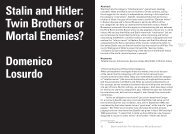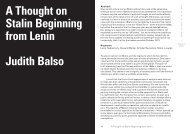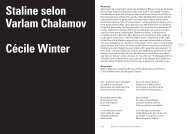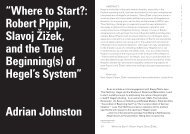Reflections on the Meaning of Stalinism Paul Le Blanc
blanc
blanc
You also want an ePaper? Increase the reach of your titles
YUMPU automatically turns print PDFs into web optimized ePapers that Google loves.
and his closest co-workers targeted such elements in part to appease<br />
disgruntled workers who had suffered at <strong>the</strong>ir hands. There are also<br />
indicati<strong>on</strong>s that in some cases <strong>the</strong> purges went whirling out <strong>of</strong> c<strong>on</strong>trol,<br />
proceeding much fur<strong>the</strong>r and more destructively than had been intended.<br />
It seems clear, however, that <strong>the</strong>re were also o<strong>the</strong>r dynamics involved.<br />
The “revoluti<strong>on</strong> from above” had generated massive disc<strong>on</strong>tent and<br />
unease, leaving c<strong>on</strong>siderable blood was <strong>on</strong> <strong>the</strong> hands <strong>of</strong> Stalin and his<br />
accomplices. Many thousands <strong>of</strong> knowledgeable people – veterans <strong>of</strong><br />
1917, comrades <strong>of</strong> <strong>Le</strong>nin – were keenly aware <strong>of</strong> <strong>the</strong> yawning gap between<br />
<strong>the</strong> ideals <strong>of</strong> <strong>the</strong> revoluti<strong>on</strong> and <strong>the</strong> seemingly out-<strong>of</strong>-c<strong>on</strong>trol practices <strong>of</strong><br />
<strong>the</strong> current regime. Stalin was undoubtedly aware <strong>of</strong> this in <strong>the</strong> very core<br />
<strong>of</strong> his being. It would make sense that many such people, <strong>on</strong> some level,<br />
might feel (as <strong>Le</strong>nin had urged in his secret testament <strong>of</strong> 1922) that Stalin<br />
should be removed. It is reas<strong>on</strong>able that he would feel <strong>the</strong>y could not be<br />
trusted. 30<br />
The fact remains that it was under Stalin’s “revoluti<strong>on</strong> from above”<br />
that <strong>the</strong> partial-modernizati<strong>on</strong> and dramatic industrial development <strong>of</strong> <strong>the</strong><br />
former Russian Empire – <strong>the</strong> Uni<strong>on</strong> <strong>of</strong> Soviet Socialist Republics – was<br />
carried out. This industrializati<strong>on</strong> was a decisive factor in <strong>the</strong> USSR’s<br />
survival and triumph over Hitler, <strong>on</strong>ce <strong>the</strong> USSR was attacked – as Stalin<br />
seemed to predict in 1931: “We are fifty or a hundred years behind <strong>the</strong><br />
advanced countries. We must make good this lag in ten years. Ei<strong>the</strong>r we<br />
do it, or <strong>the</strong>y crush us.” 31 While hardly an industrial power like Germany,<br />
Great Britain, or <strong>the</strong> United States, <strong>the</strong> USSR was in <strong>the</strong> process <strong>of</strong><br />
becoming <strong>on</strong>e when World War II began.<br />
Popular mobilizati<strong>on</strong> combining authoritarianism with extreme<br />
patriotism (with Stalin as a central symbol) was backed up by a<br />
centralized industrialism forged in <strong>the</strong> previous decade. After <strong>the</strong><br />
horrendous German <strong>on</strong>slaught <strong>of</strong> 1941, <strong>the</strong> Soviet Uni<strong>on</strong> mobilized<br />
impressively, with Russian producti<strong>on</strong> <strong>of</strong> tanks and aircraft surpassing<br />
German producti<strong>on</strong> by 1943. Out <strong>of</strong> a Soviet populati<strong>on</strong> <strong>of</strong> 200 milli<strong>on</strong>, at<br />
least <strong>on</strong>e-tenth died – but out <strong>of</strong> <strong>the</strong> 13.6 milli<strong>on</strong> German soldiers killed,<br />
wounded or missing during World War II, 10 milli<strong>on</strong> met <strong>the</strong>ir fate <strong>on</strong> <strong>the</strong><br />
Eastern Fr<strong>on</strong>t. This was decisive for Hitler’s defeat. 32<br />
The ability to hold <strong>the</strong> line against Hitler’s mighty legi<strong>on</strong>s, and<br />
<strong>the</strong>n hurl <strong>the</strong>m back and destroy <strong>the</strong>m, was <strong>the</strong> culminati<strong>on</strong> <strong>of</strong> a number<br />
<strong>of</strong> positive developments that took place in <strong>the</strong> 1920s and 1930s. A<br />
modernizati<strong>on</strong> process had taken place in <strong>the</strong> USSR’s rapidly growing<br />
urban centers and, to a lesser extent, in <strong>the</strong> rural areas – with an<br />
educati<strong>on</strong>al system reaching out dramatically at all levels, fostering a<br />
C<br />
R<br />
I<br />
S<br />
I<br />
S<br />
&<br />
C<br />
R<br />
I<br />
T<br />
I<br />
Q<br />
U<br />
E<br />
/<br />
Volume 3 /<br />
Issue 1<br />
significant upward social mobility, making <strong>the</strong> USSR a major industrial<br />
power, with gigantic metallurgical complexes, hydroelectric power<br />
stati<strong>on</strong>s, and tractor plants. Soviet heavy industry caught up with<br />
that <strong>of</strong> Western Europe (in quantity if not in quality), with <strong>the</strong> number<br />
<strong>of</strong> industrial workers rising from fewer than 3 milli<strong>on</strong> to more than 8<br />
milli<strong>on</strong>, and <strong>the</strong> urban populati<strong>on</strong> rising by almost 30 milli<strong>on</strong> — and<br />
this in a period when most <strong>of</strong> <strong>the</strong> world was in <strong>the</strong> throes <strong>of</strong> <strong>the</strong> Great<br />
Depressi<strong>on</strong>. 33<br />
In <strong>the</strong> USSR, <strong>the</strong> positive developments were projected as <strong>the</strong><br />
achievements <strong>of</strong> socialism and <strong>of</strong> its primary architect Joseph Stalin. For<br />
many in <strong>the</strong> USSR and in countries around <strong>the</strong> world, Stalin had become<br />
<strong>the</strong> pers<strong>on</strong>ificati<strong>on</strong> <strong>of</strong> revoluti<strong>on</strong>ary patience combined with a practicalminded<br />
commitment to creating a better future — a symbol <strong>of</strong> all <strong>the</strong><br />
progress in <strong>the</strong> USSR that would some day be spread throughout <strong>the</strong><br />
world.<br />
Yet it can been argued that it was not Stalin but “<strong>the</strong> October<br />
revoluti<strong>on</strong> that opened <strong>the</strong> road to educati<strong>on</strong> and culture for <strong>the</strong> Soviet<br />
people,” and that <strong>the</strong> USSR would have “traveled that road far more<br />
quickly if Stalin had not destroyed hundreds <strong>of</strong> thousands <strong>of</strong> <strong>the</strong><br />
intelligentsia, both old and new.” Roy Medvedev observes that <strong>the</strong><br />
system <strong>of</strong> forced labor “accomplished a great deal, building almost all <strong>the</strong><br />
canals and hydroelectric stati<strong>on</strong>s in <strong>the</strong> USSR, many railways, factories,<br />
pipelines, even tall buildings in Moscow. But industry would have<br />
developed faster if <strong>the</strong>se milli<strong>on</strong>s <strong>of</strong> innocent people had been employed<br />
as free workers.” 34<br />
The devastati<strong>on</strong> <strong>of</strong> Soviet agriculture that resulted from <strong>the</strong> use<br />
<strong>of</strong> force and violence against <strong>the</strong> peasants resulted in unnecessary<br />
sacrifices that “did not speed up but ra<strong>the</strong>r slowed down <strong>the</strong> overall rate<br />
<strong>of</strong> development that our country might have enjoyed.” What were seen as<br />
“victories” for <strong>the</strong> USSR during <strong>the</strong> 1930s “turned out in fact to be defeats<br />
for socialism,” fatally undermining <strong>the</strong> USSR’s future. It was a system<br />
that proved incapable <strong>of</strong> surviving <strong>the</strong> twentieth century. 35<br />
Definiti<strong>on</strong> and Challenge<br />
What has come to be termed <strong>Stalinism</strong> might be summarized as<br />
involving five interrelated comp<strong>on</strong>ents.<br />
1. A definiti<strong>on</strong> <strong>of</strong> socialism that excludes democracy as an essential<br />
element, positing a <strong>on</strong>e-party dictatorship over <strong>the</strong> political, ec<strong>on</strong>omic,<br />
and cultural life <strong>of</strong> a country.<br />
2. An insistence that it is possible to create “socialism” in this<br />
C<br />
R<br />
I<br />
S<br />
I<br />
S<br />
&<br />
C<br />
R<br />
I<br />
T<br />
I<br />
Q<br />
U<br />
E<br />
/<br />
Volume 3 /<br />
Issue 1<br />
30 <strong>Le</strong> <strong>Blanc</strong> 2006, pp. 128-131, 134; <strong>Le</strong> <strong>Blanc</strong> 2015b, pp. 110-117.<br />
33 Mayer 2000, pp. 662-662, 674; Medvedev 1989, p. 629.<br />
31 Deutscher 1967, p. 550.<br />
34 Medvedev 1989, p. 869.<br />
32 Calvocoressi, Wint and Pritchard 1999, pp. 480, 481, 484-485.<br />
35 Medvedev 1989, p. 869.<br />
96 <str<strong>on</strong>g>Reflecti<strong>on</strong>s</str<strong>on</strong>g> <strong>on</strong> <strong>the</strong> <strong>Meaning</strong> <strong>of</strong> <strong>Stalinism</strong><br />
97<br />
<str<strong>on</strong>g>Reflecti<strong>on</strong>s</str<strong>on</strong>g> <strong>on</strong> <strong>the</strong> <strong>Meaning</strong> <strong>of</strong> <strong>Stalinism</strong>






